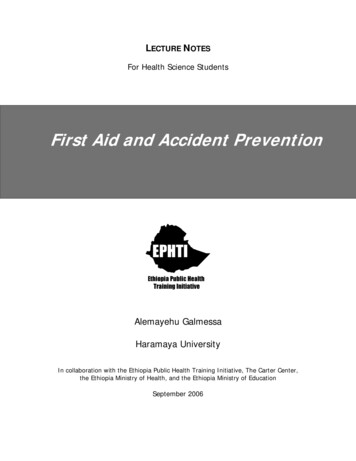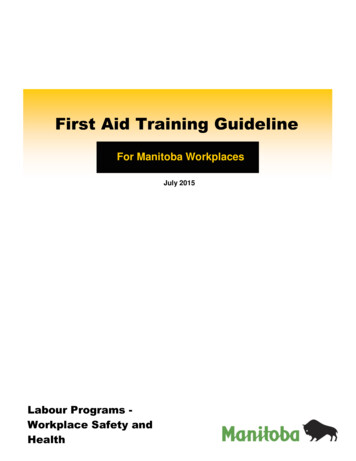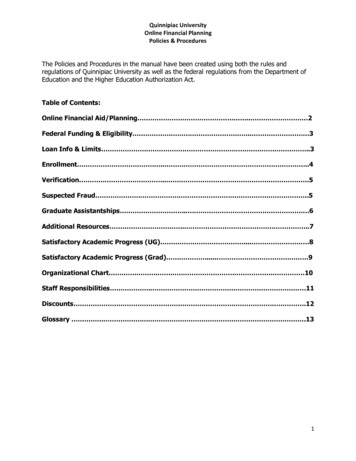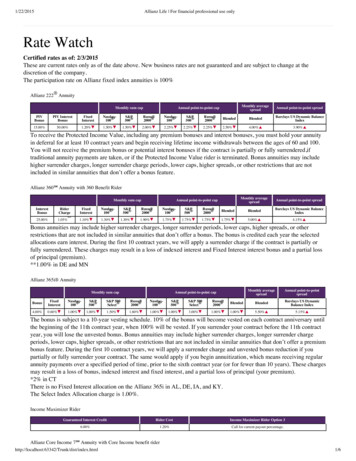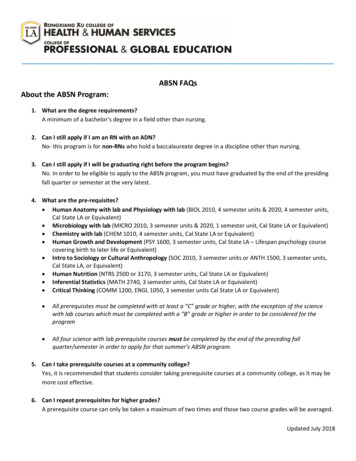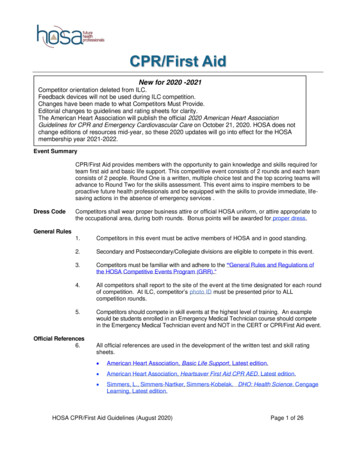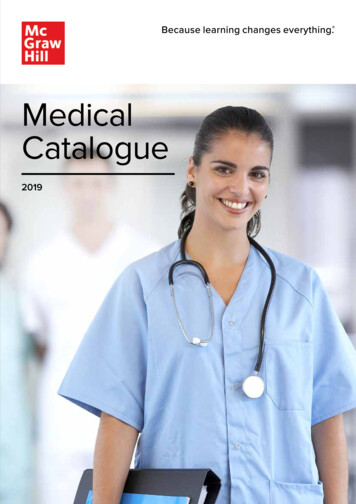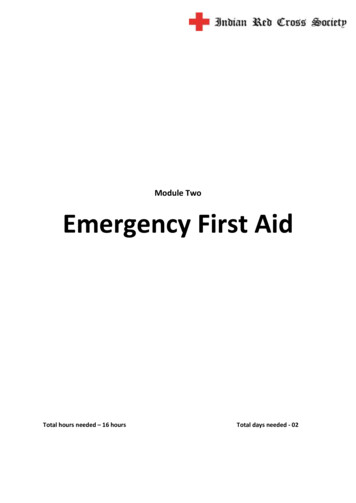
Transcription
Financial AidMade Simple
A college degreemay be moreaffordable thanyou may think.In 2019-20, undergraduate students receivedan average of 14,940 per FTE student infinancial aid: 9,850 in grants.1It may surprise you to know you don’t have tobe a straight-A student or down to your lastdollar to qualify for financial aid.2 Many grantsand scholarships are made for everyday adults,just like you, who want to better their lives.1. ge-pricing-student-aid-2020.pdf2. Financial aid available to those who qualify.
CONTENTSWhat are the rightoptions for you? .4Paying for college,realizing your dream .5What’s available for me? .6How do I find the financialaid I need? .7How do I apply? .8What information willI need to provide? .9Understandingfinancial aid terms.10Cost of Attendance. 12Additional resources .143Am I eligible?
Financial AidWhat are the rightoptions for you?Review the information below, then visit our financial aid office for moreinformation and help. Our experienced financial planners are happy to assistyou through the financial aid process.The following is a basic list of eligibility requirements for federal financial aid: Show financial need (some loan and scholarshipprograms excepted) Have a valid Social Security number. If you need a SocialSecurity number, you can apply for one at www.ssa.gov Earn your high school or home school diploma,HiSET, TASC, or GED test certificate While in attendance, meet satisfactory academicprogress standards Meet any state standardsfederally approved Comply with Selective Service registrationthathavebeen Be enrolled or accepted for enrollment as aregular student working toward a degree orcertificate in an eligible program Be a U.S. citizen or eligible non-citizen Certify that you will use federal student aid only foreducational purposes, and certify that you are notin default on a federal student loan and do not owemoney on a federal student grant4Am I eligible?Eligibility for other types of aid—includingprivate, institutional, and state aid—isdetermined by the aid-granting organization.Contact the organization for specificrequirements.
Paying for college,realizing your dreamSome people have the idea that they can’tafford college. The fact is, college may be muchmore affordable than you think. Financialaid is available to those who qualify. Many studentsare amazed at the financial aid they’re eligible toreceive. You may be wondering whether collegeis worth the expense, time, and work it takes to besuccessful. The truth is, the right degree can greatlyimprove your earning potential.1 The vast majority ofstudents today are being helped through college withfinancial assistance. 2Federal Aid ProgramType of AidProgram DetailsAnnual Maximum AwardFederal Pell GrantGrant: does nothave to be repaidAvailable almost exclusively to undergraduates. All eligiblestudents will receive the Federal Pell Grant amounts theyqualify for. 6,495 (2021–2022); subject to changeevery July 1.Federal SupplementalEducational OpportunityGrant (FSEOG)Grant: does nothave to be repaidFor undergraduates with exceptional financial need.Priority is given to Federal Pell Grant recipients.Funds depend on availability at school.Amounts vary depending on school’sallocation.Federal Work StudyMoney is earned whileattending school; doesnot have to be repaidFor undergraduates with exceptional financial need.Priority is given to Federal Pell Grant recipients.No annual maximum.Direct Subsidized LoanLoan: mustbe repaidU.S. Department of Education pays interest while theborrower is in school and during grace and defermentperiods.Amounts vary, depending on grade leveland dependent/independent status. ized-unsubsidized for info.Direct Unsubsidized LoanLoan: mustbe repaidThe borrower is responsible for the interest of unsubsidizedloans throughout the life of the loan.Amounts vary, depending on grade leveland dependent/independent status. ized-unsubsidized for info.Direct PLUS LoanLoan: mustbe repaidAvailable to parents of dependent undergraduate students.Cost of attendance minus any otherfinancial aid the student receives.Funds depend on availability at school.Amounts vary depending on school’sallocation.Source: oans1. play/education-pays.htm2. https://nces.ed.gov/fastfacts/display.asp?id 31Paying for college, realizing your dream5
FOUR BASIC SOURCESOF FINANCIAL AID:What’s availablefor me?Each financial aid option may offer both need-basedand non-need-based aid, as well as grants, loans, andwork-study programs. It’s smart to explore all yourfinancial aid options to get the best chance of receivingall the aid you need to finance your education.1. Federal aidFederal aid is need-based aid that is regulated by theU.S. Department of Education. Your financial aid willbe determined by the information you provide in yourFAFSA – Free Application for Federal Student Aid.2. State aidState-supported financial aid varies from state to stateand may have residency or attendance restrictions. Insome states, grants cover tuition and are based onfinancial need as determined by the state. Some statescholarships are based solely on merit and are measuredby academic achievement. Others are designed tosupport students interested in certain professions tohelp fill a shortage within a specific state. Search theU.S. Department of Education’s database at actinformation and website addresses.6What’s available for me?1. FEDERAL2. STATE3. INSTITUTIONAL 4. PRIVATE3. Institutional aidInstitutional aid can be need-based (income-related) or nonneed-based (performance-related) and is provided by theinstitution or school that the student is attending. Examplesof institutional aid include school-based scholarships,tuition payment plans, college partnerships, and more.At Independence University, we have a variety of grantsand scholarships* available for those who qualify. Call800-331-8831 for more information.4. Private aidPrivate aid is financial assistance that is provided by aprivate business, group, or individual. This includes aid fromgroups such as community groups, employers, religiousorganizations, ethnic organizations, private benefactors, orinvestors. Private aid can be granted based on almost anyqualification. Contact your school’s financial aid office oryour city’s chamber of commerce or community center tofind out more about local aid sources. There are also manyinternet sites that provide information about private aidresources. See this booklet’s “Additional Resources” sectionfor reliable sites (pg. 14).*Financial aid available to those who qualify.
A FEW SIMPLE STEPS COULDHow do I find thefinancial aid I need?It starts with knowing where to look. You canstart applying for federal financial aid by fillingout an online application at www.fafsa.ed.gov.Once it’s processed, you will receive notice from thegovernment through your school telling you the types ofaid for which you may qualify and, if qualified, the nextsteps to take in receiving aid.Exploring other financial aid options can begin with yourhigh school counselor or the internet. Both can be excellent resources for help in getting started. Here is a list ofhelpful websites:www.studentaid.ed.govThis site will help you find more information onfederal student aid, access FAFSA on the web (theonline version of the Free Application for FederalStudent Aid), look up the status of your federal studentloan, and access federal student aid publications.HELP YOU PAY FOR COLLEGE— AND IT’S ALL SURPRISINGLYEASY WITH OUR lling-out/helpThis site will help you complete your FAFSA.www.fastweb.comSearch over 600,000 scholarships, totaling over 1 billion.Get expert tips on financial aid, careers, and more.www.scholarships.comThis is the internet’s premier free college scholarshipsearch and financial aid information resource,connecting students and parents with college fundingopportunities. Create a personal profile, and the freescholarship search will match you to the database ofcollege scholarships. Search results include scholarshipsummaries and a customizeable application requestletter. A few simple steps could help you pay forcollege—if you qualify—and it’s all completely his is where you’ll find your Free Application forFederal Student Aid.How do I find the financial aid I need?7
NEED HELP?How do I apply?1. Apply for federal financial aid byfilling out the FAFSA (Free Applicationfor Federal Student Aid)You can apply beginning October 1 of the year you planto attend school until June 30 of the following year.Be sure to check the FAFSA for the list of deadlinesfor state aid. Schools and states often set deadlinesearly in the calendar year that you must meet toreceive certain types of funds. A word of advice:Apply early!2. Keep a copy of your applicationMake a copy of your application (or print out a copyof your FAFSA on the web application), so you’ll haveone for your records. Save all other records as wellin case there’s a need to verify the information youreported. Make sure you write down your FSA ID onceyou receive it, in case you need to provide a copy ofyour FAFSA in the future.3. Verify your information on yourStudent Aid Report (SAR)Depending on the method you used in filling it out,8How do I apply?GIVE US A CALL AT800-331-8831your Student Aid Report will be sent to you in the mailor on the internet. It confirms the information reported onyour FAFSA and indicates your Expected Family Contribution (EFC). The EFC is a measure of your family’s financialstrength and is used to determine your eligibility for federalstudent aid.4. Contact usTalk with one of our financial planners. Make sure theyhave the information to determine your eligibility. Wewill review your SAR, and we will contact you withinformation stating the amount of financial aid forwhich you may qualify. We can also refer you to otherpotential sources of financial aid.5. Research private financial aid optionsCheck with your school’s financial aid planner forhelp in finding the private financial aid options thatapply in your particular state. Also, refer to this booklet’s“Additional Resources” section (pg. 15).
What informationwill I need to provide?The following checklist will help you gather theinformation you’ll need to complete your FreeApplication for Federal Student Aid (FAFSA).By keeping copies of this information, you willsave yourself time later when you are applyingfor private aid as many colleges require the sameinformation.FAFSA checklist Your Social Security number (you can find this on yourSocial Security card) Your Prior-Prior Year (PPY) federal income tax return Your previous year’s bank statements Your previous year’s business and investment information,such as business and farm records or stocks, bonds, andother investment records (if applicable) Your alien registration card (if you are not a U.S. citizen)Helpful hints (and that of your spouse, if you are married and filingseparately) W-2 forms or other records showing money earned in the previous tax year not appearing on your PPYreturn Ifyou’re a dependent student, your parents’ PPYfederal income tax returnforeign tax returns or tax returns fromPuerto Rico (if applicable) Any YourPPY untaxed income records, including SocialSecurity, Temporary Assistance to Needy Families,welfare, or veterans’ benefits records (if applicable) Read all the school information carefully. If you have anyquestions about costs or other important topics, contactour financial aid department for the answers you need.Complete your paperwork carefully and completely,following the instructions closely.Pay close attention to deadline dates so you won’t missout on aid awarded on a first-come, first-served basis.Answer any letters or emails you receive right away. Ifyou change your email, notify your financial planner tomake sure you don’t miss important documents anddeadlines.Keep copies of everything relating to your application,including forms and communications both sent andreceived.Re-apply for financial aid by the deadline each yearto maintain eligibility. Note: Failure to re-apply by thedeadline each year could result in loss of funds andbeing dropped from your program.What information will I need to provide?9
Understandingfinancial aid termsUnderstanding the following words will make yourfinancial aid decisions easier.Academic yearAn academic year for a credit-hour or directassessment program must be defined as at least 30weeks of instructional time.Cost of attendance (COA)Cost of attendance is the total amount it will costyou to go to school, usually expressed as a yearlyfigure. COA includes tuition, fees, and on-campusroom and board (or a housing and food allowance foroff-campus students). An allowance is also includedfor books, supplies, transportation, loan fees, and, ifapplicable, dependent care. It also includes otherexpenses, including an allowance for the rental orpurchase of a personal computer. (For details aboutthe new tablet and new laptop our college supplies tostudents, please contact us.)See page 12-13 for Cost of attendance charts.DefaultDefault is a failure to repay a loan according to theterms agreed to when you signed a promissory note.The consequences of default are severe. Your school,10Understanding financial aid termsthe lender or agency that holds your loan, the state,or the federal government may take action to recoverthe money and may notify national credit bureaus ofyour default.Eligible non-citizenYou must be one of the following to receive federalstudent aid: A U.S. citizen A U.S. national (includesSamoa or Swain’s Island)nativesofAmerican A U.S. permanent resident who has an I-151, I-551, orI-551C (alien registration card)If you’re not in one of these categories, you must havean Arrival-Departure Record (I-94) from the Bureau ofCitizenship and Immigration Services (formerly the U.S.Immigration and Naturalization Service) showing one ofthe following designations: Refugee Asylum Granted Cuban-Haitian Entrant, Status Pending Conditional Entrant (valid only if issued before April 1, 1980)Other applicants should check withfinancial aid office for more information.theirschool’s
Understandingfinancial aid termsEligible programThis is a program of organized instruction or study thatleads to an academic, professional, or vocational degreeor certificate, or other recognized educational credential.To receive federal student aid, you must be enrolled in aneligible program, with two exceptions: If a school requires that you complete certaincoursework to qualify for admission into one ofits eligible programs, you can get a Direct Loanfor up to 12 consecutive months while you’refinishing that coursework. You must be enrolledat least part-time and meet the usual student aideligibility requirements.(continued)High School Equivalency(GED test, TASC test, HiSet exam)*TMThis is a certificate that students receive if they’ve passeda specific, approved high school equivalency test. Studentswho don’t have a test credential may still qualify for federalstudent aid. A school that admits students without a highschool diploma must make a test credential programavailable in the vicinity of the school and must informstudents about the program. If you are enrolled at least half-time in a programto obtain a professional credential or certificationrequired by a state for employment as an elementary orsecondary school teacher, you are eligible for a DirectLoan. In addition, your parents can apply for a PLUSLoan while you’re enrolled in that program. You mayalso qualify for the federal work study program.*GED is a registered trademark of the American Council on Education (ACE) and is administeredexclusively by GED Testing Service, LLC under license. This material is not endorsed or approvedby ACE or GED Testing Service. HiSet is a registered trademark of Educational Testing Service.TASC is a trademark of Data Recognition Corporation. All other trademarks are property of theirrespective owners.Understanding financial aid terms11
2020-2021 Cost of AttendanceRegion 1District of Columbia,Living with ParentsMonthsLiving off Campus145678145Room & 931437217965215582515128744Region 28Living off Campus145678145Room & 071322816535198422314926456Region 3Months678Hawaii, Virgin Island, Puerto Rico,Living with ParentsLiving off Campus1456781456Room & 24015300183602142024480Region 478Alaska, Connecticut, Maryland, Massachusetts, New Hampshire, New Jersey,Living with ParentsMonths127California, New York,Living with ParentsMonths61Living off Campus45678145678Room & 6814585175022041923336Cost of Living Expenses
2020-2021 Cost of AttendanceRegion 5(continued)Maine, Oregon, Rhode Island, Vermont, Washington,Living with ParentsMonths1Living off Campus45678145678Room & 213565162781899121704Arizona, Colorado, Delaware, Illinois, Nevada, Pennsylvania,Region 6Living with ParentsMonths1Living off Campus4567814567Room & 12465149581745119944Region 7Florida, Louisiana, Minnesota, Montana, Nebraska, New Mexico, North Dakota, South Carolina, South Dakota,Texas, Utah, Virginia, Wisconsin, Wyoming,Living with ParentsMonths18Living off Campus45678145678Room & 580138961621218528Region 8Alabama, Arkansas, Georgia, Idaho, Indiana, Iowa, Kansas, Kentucky, Michigan, Mississippi, Missouri,North Carolina, Ohio, Oklahoma, Tennessee, West Virginia,Living with ParentsMonths1Living off Campus45678145678Room & 740128881503617184Cost of Living Expenses13
Additional sourcesThe site for the National Association of Student FinancialThis site has publications, fact sheets, online tools, andAid Administration.other resources to help you prepare and pay for college.www.finaid.orgwww.collegedata.comGreat resources for information and links to manyPrepare, apply, and pay for college following thefinancial aid materials.advice and tools you’ll find here. Get admissions helpand scholarship search assistance.www.salliemae.comSallie Mae can provide loans to students which are paidto the school.www.bls.gov/ooh/The U.S. Department of Labor’s Occupational OutlookHandbook. This site gives detailed information on variouscareers and their potential earnings.Independence.edu
Made Simple. In 2019-20, undergraduate students received an average of 14,940 per FTE student in financial aid: 9,850 in grants.1 . financial aid options to get the best chance of receiving all t

